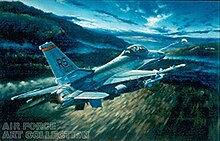Banja Luka incident
| Banja Luka incident | |||||||
|---|---|---|---|---|---|---|---|
| Part of the Bosnian War and Operation Deny Flight | |||||||
 Artist's depiction of the incident | |||||||
| |||||||
| Belligerents | |||||||
|
| |||||||
| Strength | |||||||
|
6 J-22 Oraos |
4+ F-16s | ||||||
| Casualties and losses | |||||||
|
4 aircraft shot down[1][a] 1 aircraft crashed[3][4] 3 pilots killed 1 wounded | None | ||||||
The Banja Luka incident, on 28 February 1994, was an incident in which six
Bombing of Novi Travnik
In February 1994, the
In accordance with the
Air engagement
The Bosnian Serb Jastrebs headed northwards, back to their base. At 6:45 a.m., the NATO fighters engaged their opponents. Captain Robert G. Wright fired an
After he had expended all his missiles and low on fuel, Wright handed over the chase to his wingman,
At the same time the other pair of F-16Cs, "Knight 25" and "Knight 26",
The USAF credited three kills to
This engagement was the first wartime action conducted by NATO forces since its formation in 1949.
Aftermath
Eight days later, on March 8, a Spanish Air Force
The crew managed to land the aircraft at Rijeka Airport, and Spanish technicians were later able to repair the aircraft's damage and bring it back to service in 48 hours.[16] The incident, which according to NATO took place in a zone under Croat control,[17] may have been a Bosnian Serb response to the 28 February shootdowns[18] and, though it failed to name a perpetrator, NATO labeled the incident a "provocation", while Croat defence officials blamed "Serb terrorists" and claimed that more than one missile was fired at the aircraft.[17]
Bosnian Serb pilots
The
- Capt. 1st Class Ranko Vukmirović[14] †
- Capt. 1st Class Zvezdan Pešić[14] †
- Capt. 1st Class Goran Zarić[14] ejected at low altitude, †
- Maj. Uroš Studen[14] ejected near Jajce, survived.
- Capt. 1st Class Zlatko Mikerević[14] ejected probably near the villages of Bravsko and Crkveno, 14 kilometres (9 mi) west of Ključ, survived.
- Capt. 1st Class Zlatan Crnalić[14] landed at Udbina Airport with his J-21 Jastreb Sr.nr. 24275 badly damaged; the aircraft later re-entered service.
See also
- Mrkonjić Grad incident
Notes
References
- ^ "USAF F-16s shoot down 4 Serb attack aircraft – F-16 News". f-16.net.
- ^ AFSOUTH Fact sheets Archived 2006-08-21 at the Wayback Machine
- ^ Serbian officially admitted 5 Aircraft lost
- ^ "Hronika Republike Srpske Krajine www.krajinaforce.com". krajinaforce.com.
- ^ "First NATO Military Action".
- ISBN 978-1-59884-530-3.
- ^ Call sign of the aircraft
- ^ Owen, Robert C. (1997). Deliberate Force: A Case Study in Effective Air Campaign. Maxwell Air Base, Alabama: Air University Press. p. 405.
- ^ Capt. Robert G. Wright nickname (sometimes a.k.a. Capt. Bob G. Wright)
- ^ "Airframe Details for F-16 #89-2137". f-16.net.
- ^ Capt. Stephen L. Allen nickname (sometimes a.k.a. Capt. Steve L. Allen)
- ^ "Airframe Details for F-16 #89-2009". f-16.net.
- ^ "See the aircraft's tail picture on Bushev F-16 u praksi". Archived from the original on 2011-10-14. Retrieved 2011-10-21.
- ^ a b c d e f g Lista gubitaka/ostecenja vazduhoplova u Ex-JRV od 1945 godine do danas
- ^ "La OTAN considera una "provocación" el ataque a un avión militar español". EL PAÍS (in Spanish). 1994-03-09. Archived from the original on 5 December 2016. Retrieved 2017-05-05.
- ^ "Ejército del aire. Ala 37". www.ejercitodelaire.mde.es. Archived from the original on 5 January 2010. Retrieved 19 April 2022.
- ^ a b El País, 9 March 1994
- ^ Air Defense Artillery. U.S. Army Air Defense Artillery School. 1996. p. 19.
Further reading
- Philip Handleman, Combat in the Sky: The Art of Air Warfare, Zenith Press 2003. ISBN 978-0-7603-1468-5.
